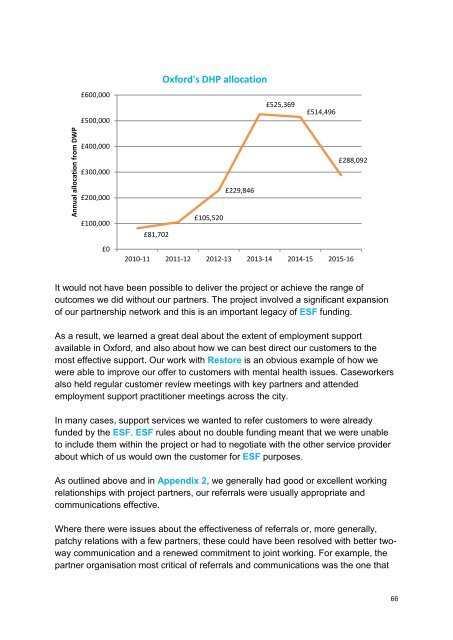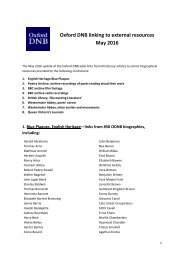Welfare Reform Team Evaluation of European Social Fund pilot project 2014-2015
welfare_reform_european_social_fund_project_evaluation_report
welfare_reform_european_social_fund_project_evaluation_report
Create successful ePaper yourself
Turn your PDF publications into a flip-book with our unique Google optimized e-Paper software.
£600,000<br />
£500,000<br />
Oxford's DHP allocation<br />
£525,369<br />
£514,496<br />
Annual allocation from DWP<br />
£400,000<br />
£300,000<br />
£200,000<br />
£100,000<br />
£0<br />
£288,092<br />
£229,846<br />
£105,520<br />
£81,702<br />
2010-11 2011-12 2012-13 2013-14 <strong>2014</strong>-15 <strong>2015</strong>-16<br />
It would not have been possible to deliver the <strong>project</strong> or achieve the range <strong>of</strong><br />
outcomes we did without our partners. The <strong>project</strong> involved a significant expansion<br />
<strong>of</strong> our partnership network and this is an important legacy <strong>of</strong> ESF funding.<br />
As a result, we learned a great deal about the extent <strong>of</strong> employment support<br />
available in Oxford, and also about how we can best direct our customers to the<br />
most effective support. Our work with Restore is an obvious example <strong>of</strong> how we<br />
were able to improve our <strong>of</strong>fer to customers with mental health issues. Caseworkers<br />
also held regular customer review meetings with key partners and attended<br />
employment support practitioner meetings across the city.<br />
In many cases, support services we wanted to refer customers to were already<br />
funded by the ESF. ESF rules about no double funding meant that we were unable<br />
to include them within the <strong>project</strong> or had to negotiate with the other service provider<br />
about which <strong>of</strong> us would own the customer for ESF purposes.<br />
As outlined above and in Appendix 2, we generally had good or excellent working<br />
relationships with <strong>project</strong> partners, our referrals were usually appropriate and<br />
communications effective.<br />
Where there were issues about the effectiveness <strong>of</strong> referrals or, more generally,<br />
patchy relations with a few partners, these could have been resolved with better twoway<br />
communication and a renewed commitment to joint working. For example, the<br />
partner organisation most critical <strong>of</strong> referrals and communications was the one that<br />
66




